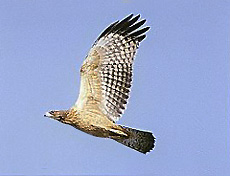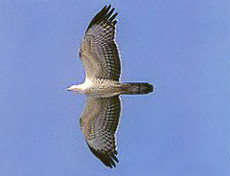Although raptors are great environmental indicators and amongst the most popular of birds, their migration through South Korea remains relatively unknown, due largely to a combination of the difficulty of identification, the scarcity of birders, and the geography of the peninsula.
No co-ordinated surveys to establish numbers of birds involved had been done before Sept/Oct 2002, and with 70% of the country mountainous, an abundance of islands but a lack of concentrating land features (such as narrow sea straits or long peninsulas) it is difficult to find obvious migration routes.
However, looking at data collected on the Japanese island of Tsushima (Tema Do in Korean) only 50 km SW of Busan and 45 km SE of Koje Island, it is clear that probably several hundred thousand Chinese Sparrowhawks migrate down and out of South Korea in September each year. Observations in Jeollanam Do, most especially on Gageo and Daeheuksan Islands, also suggests a reasonable migration of raptors out from the southwest across the Yellow Sea into China.
Clearly South Korea is important for raptor migration.
The commonest and most commonly confused migratory species are probably the accipiters, and the Grey-faced Buzzard Butastur indicus and the Crested Honey Buzzard Pernis ptilorhynchus.
Four species of accipiter have so far been found in Korea and all appear to be reasonably regular and locally common seasonally and on migration: Chinese Sparrowhawk Accipiter soloensis, Japanese Sparrowhawk Accipiter gularis, Northern Sparrowhawk Accipiter nisus, and Northern Goshawk Accipiter gentilis.
The following notes are aimed at describing some of the more useful criteria for identifying high-flying birds on migration, concentrating on the overall structure, the shape (more than the size), and on the flight action. These should be used in conjunction with more detailed information to be found in field and photograph guides. Terms used in the short accounts include “shoulders” (the leading edge of the inner wing), and “fingers” (those primaries that can be easily individually discerned when accipiters and larger raptors soar, the more fingers generally meaning the blunter the wingtip appears).
Unless specified, all images are copyright of the Asian Raptor Research and Conservation Network, and were distributed by Yasunori Nitani.
Chinese Sparrowhawk Accipiter soloensis
Overall structure:
Small, broad-headed, short-necked, full-chested. Compact, with medium-length tail (sometimes showing protruding central tail feathers). Wings appear medium-long or even shortish, with usually only 4 fingers visible.
High Flight:
Quite powerful; rapid pigeon-like wing action, often used more continuously when climbing up into thermals. When soaring can look rather like a miniature buzzard; in direct flight a little more falcon-like.
Plumage in flight:
Adults show thick black primary tips and rather plain under-wings and underparts, often with a contrastingly darker head. Juveniles and first summers are dark-headed with coarse streaking and barring below. At all ages underwing coverts plainer than other accipiters, but often difficult to discern on high-flying birds. Primaries look plainer (not as checkered looking or as translucent as some other species).
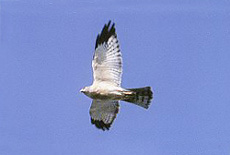
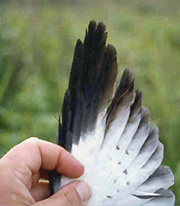

Japanese (Lesser) Sparrowhawk Accipiter gularis
Overall structure
Small, but biggest females larger than smallest male nisus. Typically head looks more triangular, with a longer neck than soloensis, and often faintly concave shoulders. Chest looks weak, and body rather flat from the side; weak hipped. Medium or medium-long tail, sometimes showing cleft. 4 or 5 fingers visible.
High Flight
typically rather weak; slow glides, and rapid wing action to accelerate, often with body rocking from side to side. Occasionally wing action near continuous.
Plumage in Flight
Juveniles streaked and barred below, little less coarse than in soloensis.
Dark-headed, but often with strong supercilium, approaching nisus. Adult Females like nisus, but supercilium less distinct; often rather darker, greyer looking overall. Sometimes shows weak barring across much of vent. Adult Males: can be deep blue on upperparts; dark-headed, underparts paler, cleaner less rufous than in typical nisus (barring difficult to discern at even medium range).
At all ages, underwings heavily barred (but barring on underwing coverts can be difficult to see on high-flying birds). Some individuals show extensive translucency along secondaries and at the bases of the primaries.



Eurasian Sparrowhawk Accipiter nisus
Overall structure
typically rather powerful looking, bulky, strong and deep-chested, with head protruding from rather powerful, often straight shoulders. Rather long-tailed and long-winged; often obvious bulge on the secondaries, and swollen hips. 5 or 6 fingers. Rarely looks pointed-winged.
High Flight
usually quite powerful; several rapid flaps (without obvious sideways rocking) in shallow climb followed by slight descending glide, repeated. Often soars at lower heights than e.g. soloensis.
Plumage in Flight
Juveniles and Females largely barred below, with contrastingly white vent. Often show strong supercilium. Translucency most obvious on bases of inner primaries?
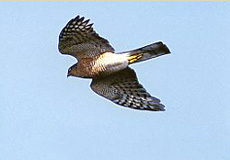
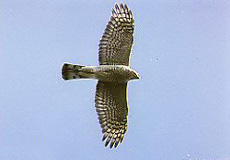

Northern Goshawk Accipiter gentilis
Overall Structure
Typically very powerful looking, with long head and neck, and long tail, with diagnostic rounded corners; powerful chest (not steep as in many nisus as whole body fuller) and very full hips. Wings long and very broad, with 5 or 6 fingers.
High Flight
Flight action appears slow; several wing beats followed by long straight glides, without the dipping shown by nisus.
Plumage in Flight
Juveniles very distinctive, washed brown or very rarely creamier below, heavily streaked. Adults heavily barred, with baggy white vent. Supercilium strong and often obvious.


Crested Honey Buzzard Pernis ptilorhynchus
Overall structure
Rather large and bulky-looking, with most distinctively a long neck with a small pigeon-like head, long, broad wings (often with an obvious secondary bulge) and a longish tail.
High Flight
Reasonably elastic, with several fairly rapid wing-beats (slower and shallower than Grey-faced Buzzard.) followed by much soaring and gliding (when can suggest small eagle). When gliding, wings sometimes held slightly arched.
Plumage in Flight
Extremely variable, ranging from largely dark to largely white below. Often Adults show 2 clear tail bars, while Juveniles show 3 or more thinner ones.


Immature Crested Honey Buzzard
Overall structure
Rather large and bulky-looking, with most distinctively a long neck with a small pigeon-like head, long, broad wings (often with an obvious secondary bulge) and a longish tail.
High Flight
Reasonably elastic, with several fairly rapid wing-beats (slower and shallower than Grey-faced Buzzard.) followed by much soaring and gliding (when can suggest small eagle). When gliding, wings sometimes held slightly arched.
Plumage in Flight
Extremely variable, ranging from largely dark to largely white below. Often Adults show 2 clear tail bars, while Juveniles show 3 or more thinner ones.
